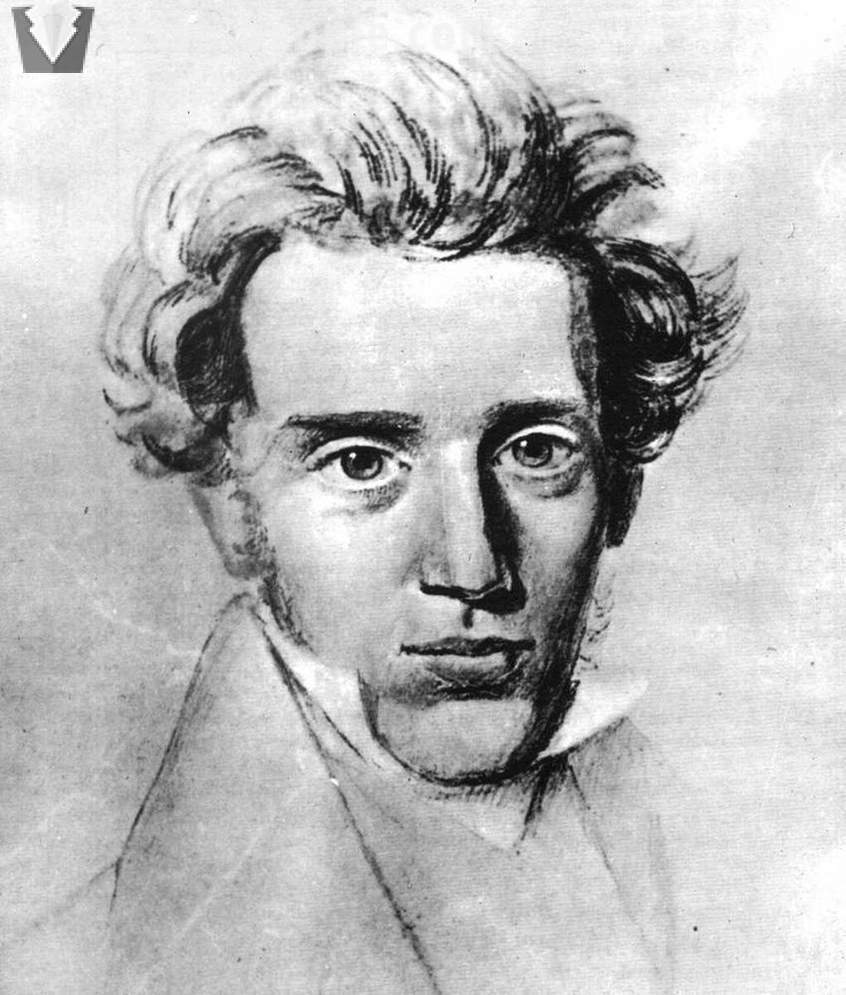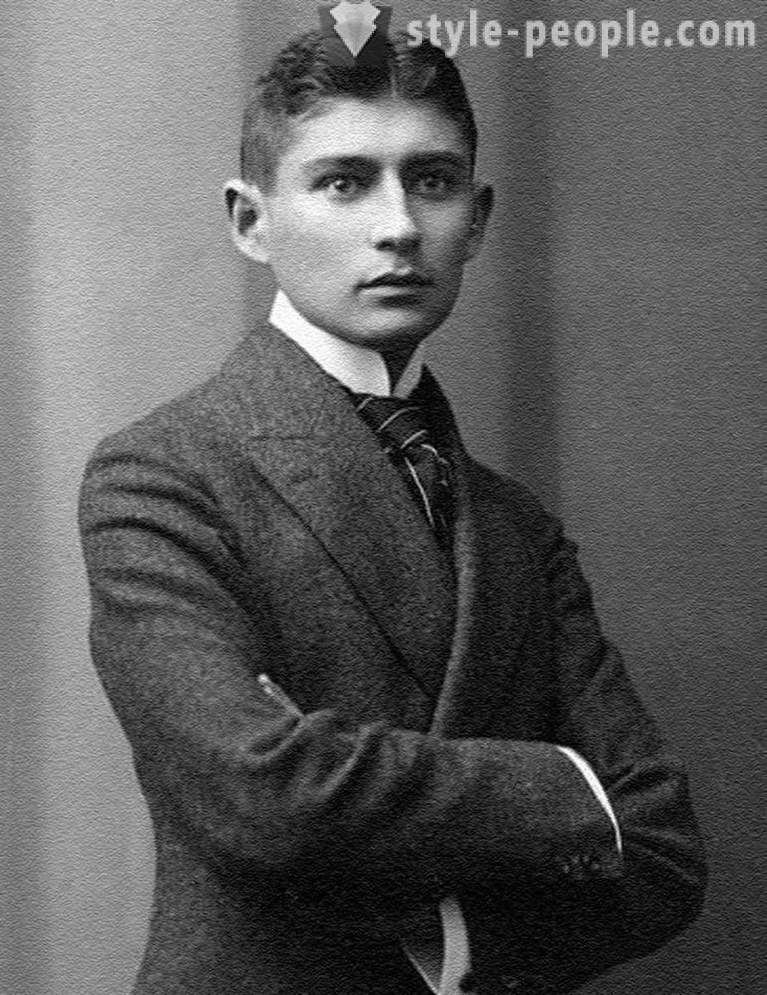Crazy life stories of famous existentialists

On how Dostoevsky stood on the scaffold, Sartre was narkomanovym equivalent of Superman, Kierkegaard published under pseudonyms to avoid responsibility, Nietzsche went mad, save a horse, as Kafka wrote reviews about prostitutes.
Existentialism - philosophy, focuses on human existence and flourished in post-war Europe in 1940-1950-ies. Thinkers puzzling and human existence in general and his own in particular. Their lives seemed bizarre blending of mental disorders caused by drugs, who took the geniuses, and a flurry of reactions of the society in which they lived.
A small part of the strange facts about the most prominent existentialist on materials Critical Theory of the world.
1. Jean-Paul Sartre was obsessed with the crabs. And mescaline.

Jean-Paul Sartre, the work with a fluffy cat called Nothing.
Jean-Paul Sartre - the influential French philosopher and writer, who declared that "hell - it's the other", and "life - nausea." At the time, an idle dissolute sex life with a companion-ekzistentsialistkoy Simone de Beauvoir, Sartre was catching bugs and talked with crabs.
In 1929, when he attended the Ecole Normale Supérieure ( "ENS de Paris", one of France's most prestigious institutions of higher education), Sartre decided to try mescaline, the hallucinogenic drug similar to LSD. But instead of a miserable bad trip, a philosopher in his reaction reached a new level. Crabs began to pursue him on his heels. All time. Whatever he went where. In an interview with a political science professor John Gerassi Sartre noted that once the crabs even chased them along the Champs Elysees in Paris.
They followed me through the streets, into class. I'm used to them. I woke up in the morning and say, "Good morning, my little, how did you sleep?" I would talk to them all the time. Philosopher thought mad and turned to his good friend and psychoanalyst Jacques Lacan. As Sartre said, and together they came to the conclusion that the crab symbolized his fear of being alone.
The crabs stayed with me until the day before I decided that they bored me and I just will not pay attention to them ...
These were my crab. I'm used to them. I wanted to come back.
Crab motive rooted in the works of Sartre. He regularly referred to these arthropods, in his works. The most insane use of crab found in "The Condemned of Altona", where the protagonist of Franz imagines that to the thirtieth century, humanity will disappear, but instead will live superintelligent crabs, for which he recorded his solemn monologues.
2. Speaking of mescaline, Sartre was essentially narkomanovym equivalent of Superman.

Before Hunter S. Thompson rode in a convertible full of acid, cocaine, mescaline and tequila, it's all used the Jean-Paul Sartre.
According to Annie Cohen-Solal, who wrote a biography of Sartre, in his daily diet consisted of: two packs of cigarettes, several tobacco pipes, a quart of alcohol (wine, beer, vodka, whiskey, etc...), Two hundred milligrams of amphetamines, fifteen grams of aspirin , a lot of barbiturates, some coffee, tea and a few "heavy foods" (whatever it was). He surprised his disease, because of which from time to time had to cut back on the consumption of tobacco and drugs. I lived in '74 and died of lung cancer.
It remains to wonder how lazy eye Sartre was the result of his constant killed.
3. Søren Kierkegaard used a variety of aliases original, worthy of the pages of Harry Potter.

Søren Kierkegaard - the father of existentialism. Although his work was preceded by the introduction of the term "philosophical existentialism", he profoundly influenced thinkers of the 20th century, especially in the French novelist and philosopher Albert Camus. Kierkegaard published his works under a variety of controversial aliases to evade responsibility for everything expressed. Philosopher wanted to convey to readers that everything contained under pseudonyms, does not correspond to his personal views and beliefs. Some of the pseudonyms of Kierkegaard: Johannes de Silencio (John the Silent), Anti-Climacus, Hilarius Bookbinders, Vigilius Haufniensy, Constantine, Constantius, Victor Eremo (or Victorious Hermit).
Father and grandfather of the philosopher came from the peasants. His mother and five brothers and sisters died one after the other, before he was 21. Søren father said that death - God's punishment. For what it was, this car is unknown, it should be for something very bad.
4. Albert Camus liked the zoo in Central Park, and all his knowledge, he was obliged to football.

In the photo above is not just a gentleman who loves to dance. This Albert Camus, the French writer and existentialist, hated labels and famous for the story "The Outsider" (or "Alien"). For his work won several awards, including the Nobel Prize for Literature. His friend Jean-Paul Sartre declined the award in 1964.
Everything else Camus was an avid soccer player, until tuberculosis forced him to quit the sport.
He stood at the gate, and said that this position is less impact on the shoe, so eliminating the wrath of my grandmother, who checked the soles for wear and, if she did not like the results, she beat him. Camus once said:
All that I know about morality and human duty I owe to football.
Throughout his life, Camus was known quirks. He wrote standing up, kept a cat named cigarette, never locked his car and tried to do yoga, falling into depression after receiving the Nobel Prize.
But the strange thing seems to have happened with Camus during his only visit to New York. He was so pleased with Central Park Zoo that he visited him twenty times. Life is meaningless, but these adorable penguins give the whole value.
5. Franz Kafka loved strange porn and paid for sex.

Franz Kafka is known for his bleak existential works reflect his neurotic personality. The writer's works are widely used by philosophers such as Gilles Deleuze and Felix Guattari, investigating and punishing power.
In addition to the writing of "Metamorphosis", "Process" and other books, Kafka also wrote reviews of sex workers whose services are paid for.
On a prostitute, he reported that she was "too old to keep a melancholic mood, even though it was painful, if not surprising, that someone not so nice with a whore like the girl in the novel. Because she did not console me, I consoled her. "
Kafka lost his virginity in 1903 with the saleswoman, who moonlighted as a prostitute. Since then, he has been a regular visitor to brothels in the period of study at the university.
When Kafka did not pay for sex, he conquered the older women while on holiday in Switzerland.
But in their sexual adventures writer he was extremely controversial.
Sex, it seemed both necessary and disgust. Intimate contact is attracted by the call of the writer's flesh; but he was concerned about the act of physicality. He could not bear the functions of the body, but the body itself has undeniably attractive qualities. It was a crisis that he has not authorized, and the whole string of relationships, in which he got involved, has brought its share of mixed impulses, frustrated desires and sexual dissatisfaction. This conflict was reflected in his work. Almost all works, you can easily recognize the thread of erotic disturbances.
Some argue that scientists have concealed prolific sex life of Kafka, to support his martyr's image. But the writer and literary critic James Hawes took on a serious academic problem unearth not only the sexual life of Kafka, but his taste in porn. All he found was published in the book "Excavating Kafka". First appeared cache frank pornography, which subscribed to Franz Kafka, and that persistently ignored researchers seeking to preserve the sanctity of the image of a cult writer.
James Hawes chanced upon a copy of journals in the British Library in London and the Bodleian Library at Oxford, doing unrelated research. Some of these erotic material he covers in his book to debunk the myth that has been fanned by the writer and which is hardly consistent with the outrageous illustrations of the banned magazines.
Hawes said about Kafka's collection: "Some of them are pretty grim, with animals, commit fellatio, and acts in the performance of a girl with a girl ... it's pretty unpleasant."
6. Nietzsche went mad, save a horse whipping, and began to consider himself Napoleon

Friedrich Nietzsche wrote his teaching before becoming a philosophy of existence. However, his devastating critique of the Judeo-Christian morality and affirmation of life in this world without the possibility of superiority over others was crucial for the development of existential thinkers. The philosophy of life was full of pain and tragedy, as well as many of his followers.
Once Nietzsche saw on the street in Turin cabby beat his horse. The sight shocked philosopher and caused him mental collapse. It is known that he ran to her and tried to defend before you hit the ground. After this incident, Nietzsche was in a psychiatric hospital, and remained ill for the rest of life. Béla Tarr and Ágnes Hranitski included this scene in the film "The Turin Horse".
Writer and philosopher Alain de Botton said that after the incident, Nietzsche horse "returned to his guest house, she danced naked" and thought to shoot the German Kaiser. More Botton said that Nietzsche began to consider themselves periodically Jesus, Napoleon, Buddha and other historical figures. Preserved letters that Nietzsche wrote to his friends already in a state of mental disorder. Most of them are signed "Dionysus" and "Crucified". Friedrich Nietzsche died at age 56 years, 11 years after the incident with the horse. In recent years, when he was bedridden, his sister stole philosopher and edited works in accordance with the program of the German nationalists, who later formed the Nazi party. Although Nietzsche himself opposed German nationalism and openly spoke out against anti-Semitism.
7. Work Simone de Beauvoir is still prohibited in the Vatican for the lesbian propaganda

Simone de Beauvoir - ideologist of the feminist movement and the representative of existential philosophy, picked up the idea of the definition of existential ethics where stopped by Jean-Paul Sartre, and create a work of "the ambiguity of morality". During World War II, she wrote a novel, "The blood of others", recognized in the United States "a textbook of existentialism."
Another work of Simone de Beauvoir's "The Second Sex", is still in the Vatican banned book list due to a strong lesbian content.
Simone de Beauvoir, consisting in an open relationship with Sartre was known relationship with his 17-year-old pupil Bianca Lamblin, who was also at the time met with Sartre. Bianca later wrote an autobiographical essay about her relationship with de Beauvoir and Sartre's "Memories of the abnormal girl", published in English as "shameful."
8. Camus, in fact, predicted his own death

Albert Camus was not easy. Born poor. Married morfinistke. She tried to commit suicide. He married again, but continued to pursue other women. Due to bouts of depression and tuberculosis remained unhealthy most of his life.
Besides all this, Camus said earlier that the most senseless way to die - a car accident. And he died in 1960, being in a car that was carrying the writer from Provence to Paris and flew off the road. Mystic. Or, according to one version, the accident rigged KGB for anti-communist speech Camus.
9. Dostoevsky was a few seconds from the penalty

In the propensity to create the most psychologically interesting characters in the literature of Fyodor Mikhailovich appreciated Nietzsche and Freud. A Russian philosopher M. Α. Maslin wrote, "Dostoevsky's worldview - is existential philosophizing type of philosophy of human existence."
His most powerful existential experience experienced writer on the scaffold. December 22, 1849, he stood on the parade ground with Petrashevists Semenov, where they read out the verdict of "death by firing squad." Firing squad was ready for execution when the adjutant galloped to the paper, which said the death penalty and replace the reference to hard labor.
If that penalty is still held, the world would not have seen the most significant works of the writer, including "Crime and Punishment" and "The Brothers Karamazov."













































